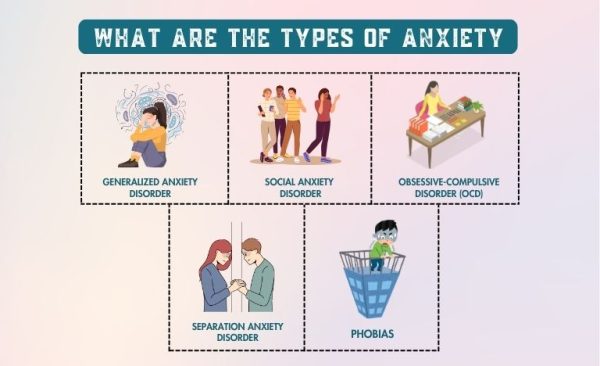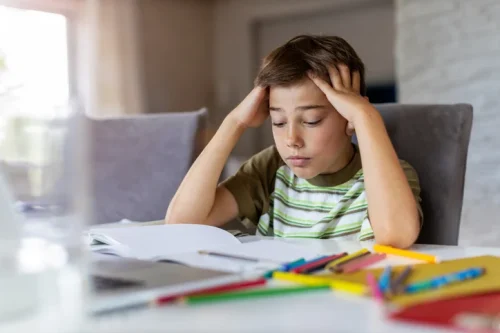Children with Autism feel stressed in many situations, which can make daily life, social interactions, and learning difficult. They may show anxiety by repeating actions, avoiding certain places, or having trouble with changes in routine. Many children with autism find it hard to express their feelings, so their anxiety may not always be noticed. Things like loud noises, bright lights, or schedule changes can make them feel more stressed. If not managed, anxiety can lead to problems in school, trouble making friends, and emotional struggles. With the right support, such as clear routines, visual aids, and professional help, children with autism can feel safer and more confident.
What is Anxiety in Children?
Anxiety in children is a natural stress response, but when it becomes excessive, persistent, and interferes with daily activities, it may be classified as an anxiety disorder. Children with autism are particularly susceptible to anxiety due to difficulties in communication, social interaction, and sensory sensitivities.
Anxiety in children with autism can appear as heightened fear, excessive worry, or extreme distress in certain situations. Unlike neurotypical children, who may be able to express their feelings verbally, children with autism may exhibit their anxiety through behaviors such as aggression, avoidance, or self-stimulatory activities. Understanding these differences is crucial for proper diagnosis and intervention.

Why Anxiety Happens in Children?
Anxiety in children can be caused by a variety of factors, both internal and external. Some common reasons include:
- Genetics: Children with a family history of anxiety disorders are more likely to develop anxiety themselves.
- Brain Chemistry: Imbalances in neurotransmitters such as serotonin and dopamine can contribute to heightened anxiety levels.
- Environmental Stressors: High-pressure situations such as school, social interactions, or major life changes can trigger anxiety.
- Trauma or Past Experiences: Negative experiences, such as bullying, neglect, or sudden losses, can lead to long-term anxiety issues.
- Parental Influence: Children often absorb their parents’ stress or anxious behaviors, which can contribute to their own anxiety.
- Medical Conditions: Some medical conditions, such as thyroid disorders or gastrointestinal problems, can exacerbate feelings of anxiety.
- Sensory Overload: Children, especially those with autism, may struggle with loud noises, bright lights, or crowded spaces, leading to anxiety episodes.
What Are the Types of Anxiety?
There are several types of anxiety disorders in children, including:
- Generalized Anxiety Disorder (GAD): Excessive worry about daily activities or future events, leading to restlessness, irritability, and difficulty concentrating.
- Social Anxiety Disorder: Intense fear of social situations and interactions, leading to avoidance of group activities, school, or public places.
- Obsessive-Compulsive Disorder (OCD): Repetitive behaviors or thoughts aimed at reducing anxiety, such as handwashing, checking, or arranging objects in a particular way.
- Separation Anxiety Disorder: Fear of being separated from caregivers, which can result in refusal to go to school or extreme distress when left alone.
- Phobias: Intense fears of specific objects or situations, such as loud noises, crowded places, or certain textures.
- Panic Disorder: Sudden, intense episodes of fear accompanied by physical symptoms like a racing heart, sweating, and difficulty breathing.

What Are the Symptoms of Anxiety in Children?
Identifying anxiety in children with autism can be challenging, as their way of expressing distress may differ from neurotypical children. Some common signs include:
- Increased repetitive behaviors (e.g., hand-flapping, rocking, pacing)
- Avoidance of certain social situations or tasks
- Difficulty transitioning between activities or environments
- Sudden emotional outbursts or meltdowns
- Physical symptoms such as stomachaches, headaches, nausea, or rapid breathing
- Sleep disturbances, including trouble falling asleep or waking up frequently
- Heightened sensitivity to sensory stimuli, leading to withdrawal or distress
- Increased reliance on routines and rituals to feel secure
- Inability to focus or complete tasks due to persistent worry
What Are the Complications of This Condition?
If left untreated, anxiety in children with autism can lead to several complications, including:
- Increased behavioral challenges: Heightened anxiety can cause aggressive outbursts, self-injurious behaviors, or extreme withdrawal.
- Academic difficulties: Anxiety can interfere with learning and school performance by making concentration and participation challenging.
- Social isolation: Avoidance of social interactions can result in loneliness, reduced self-confidence, and difficulty forming friendships.
- Depression: Prolonged anxiety can lead to depressive symptoms, lower self-esteem, and feelings of hopelessness.
- Sleep disturbances: Chronic anxiety can contribute to insomnia, frequent nightmares, or restless sleep, affecting overall health and cognitive function.
- Physical health issues: Long-term anxiety can lead to digestive issues, muscle tension, and chronic headaches, further impacting a child’s well-being.
- Increased dependency: Children with severe anxiety may become overly dependent on caregivers for comfort, making it harder for them to develop independence.
Causes of Anxiety in Children with Autism
Several factors contribute to the development of anxiety disorders in children with autism, including:
1. Sensory Sensitivities
Children with autism often have heightened sensory sensitivities, making them more prone to anxiety. Loud noises, bright lights, or unfamiliar textures can trigger anxiety episodes. For example, a child may become extremely distressed in a noisy shopping mall or refuse to wear certain clothing due to its texture.
2. Difficulty with Social Interaction
Social challenges, such as struggling to understand facial expressions, body language, or social norms, can lead to social anxiety disorder in children with autism. They may feel confused or overwhelmed in group settings, leading to withdrawal or avoidance of social interactions.
3. Rigid Thinking Patterns
Children with autism regularly rely on routines and predictability. Any changes or disruptions in their schedules can cause heightened stress and anxiety. Unexpected changes, such as a substitute teacher or a change in daily routine, can trigger severe distress.
4. Communication Barriers
Difficulty expressing emotions and needs can lead to frustration and increased anxiety in children with autism. If they are unable to verbalize their fears or discomfort, they may express their anxiety through disruptive behaviors or self-soothing activities.
5. Genetic and Biological Factors
Research suggests that anxiety disorders can have a genetic component, meaning that children with autism who have a family history of anxiety may be more prone to developing it themselves.

How to Manage Anxiety in Children with Autism
Managing anxiety in children with autism requires a multi-faceted approach that includes emotional support, behavioral strategies, and therapeutic interventions. Here are some detailed ways to help:
1. Create a Predictable and Structured Environment
Children with autism thrive in structured environments. Maintaining a consistent routine reduces uncertainty and provides a sense of control, which can help lower anxiety levels.
- Use visual schedules with pictures or symbols to help children anticipate daily activities.
- Avoid sudden changes and prepare the child in advance if a change is unavoidable.
- Designate quiet spaces where the child can retreat if they feel overwhelmed.
2. Teach Coping and Relaxation Techniques
Helping children with autism develop self-regulation skills can reduce anxiety episodes.
- Deep Breathing Exercises: Teach simple breathing techniques, such as inhaling for four seconds, holding for four seconds, and exhaling for four seconds.
- Mindfulness Activities: Encourage activities like yoga, guided meditation, or listening to calming music.
- Sensory Strategies: Provide weighted blankets, stress balls, or noise-canceling headphones to help children manage sensory overload.
3. Encourage Social and Emotional Learning
Teaching children with autism how to recognize and express their emotions can help reduce anxiety.
- Use emotion charts or flashcards to help children identify their feelings.
- Practice role-playing scenarios to prepare children for social interactions.
- Reinforce positive behaviors with praise and rewards.
4. Seek Professional Support
Therapies such as cognitive-behavioral therapy (CBT), occupational therapy, and speech therapy can be beneficial in addressing anxiety disorders in children with autism.
- Cognitive-Behavioral Therapy (CBT): Helps children identify anxious thoughts and develop coping mechanisms.
- Occupational Therapy: Supports sensory integration and helps with motor planning.
- Speech Therapy: Assists children in expressing their emotions and communicating their needs.
Conclusion
Anxiety disorders in children with autism can significantly impact their emotional and social well-being. By understanding the signs, causes, and management strategies for anxiety in children, parents, and caregivers can create a supportive environment that fosters confidence and resilience. Early intervention and tailored support can go a long way in helping children with autism navigate their world with less anxiety and greater ease.

